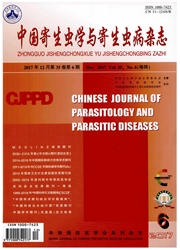

 中文摘要:
中文摘要:
目的观察弓形虫可溶性速殖子抗原(STAg)联合重组人干扰素γ(IFN-γ)佐剂滴鼻免疫BALB/c小鼠诱导的肠相关淋巴组织(GALT)和系统免疫应答及抗弓形虫感染能力。方法 BALB/c小鼠72只随机分为免疫组和对照组。免疫组用STAg 20μg/只+IFN-γ佐剂1 000U/只(溶于20μl PBS中)滴鼻免疫,对照组用等量PBS滴鼻。共滴鼻免疫2次,间隔14d。于末次滴鼻后第14d两组各处死6只小鼠,取血并收集肠冲洗液,ELISA法测定IgG、IgA抗体;制备脾淋巴细胞、PP结淋巴细胞和肠上皮内淋巴细胞(intestinal intraepithelial lymphocytes,IEL)悬液并计数。用4×104个速殖子/只灌胃攻击其余小鼠。攻虫后第30d处死,计数肝脏、脑内速殖子数。结果免疫组小鼠小肠冲洗液IgA和IgG水平均显著高于对照组(P〈0.05),血清IgG抗体水平高于对照组(P〈0.05)。免疫组小鼠肠黏膜诱导部位PP淋巴细胞和效应部位IEL及脾淋巴细胞与对照组比较显著增生(P〈0.05)。攻击后30d,免疫组小鼠存活率为83.33%,对照组为40.00%,差异有统计学意义(P〈0.05),与对照相比,免疫组小鼠肝、脑内速殖子数分别减少86.62%和86.83%(P〈0.05)。结论 STAg联合IFN-γ滴鼻免疫BALB/c小鼠能诱导GALT和系统免疫应答,从而抵抗弓形虫感染。
 英文摘要:
英文摘要:
Objective To study GALT and systemic immune responses after intranasal immunization with STAg and IFNy in order to protect mice against Toxoplasma gondii. Methods BAI.B/e mice were randomly divided into two groups, an immu- nized group and a control group, with 36 mice per group. Mice were intranasally immunized with 20 td of STAg and IFN-γ (20 μg STAg + 1000 U IFN-γ) per mouse twice at an internal of 14 days, while the control mice were given a PBS solution instead. Six mice from each group were sacrificed 14 days after the final immunization. Specific IgG and IgA antibodies in serum and intes- tinal washes were detected with ELISA. Lymphocytes in the spleen and Peyer's patches (PP) and intestinal intraepithelial lym- phocytes (IEL) were isolated and counted. Remaining mice were challenged intragastrically with 4 × 104 tachyzoites per mouse 14 days after the final immunization. The number of tachyzoites in the liver and brain was determined microscopically 30 days after challenging. Results There were large numbers of specific antibodies in intestinal washes after immunization. Immunized mice had higher levels of IgA and IgG antibodies in intestinal washes than did the control (P〈0.05). IgG antibodies in serum in- creased significantly after immunization (P〈0.05). Immunized mice had more lymphocytes in the spleen and PP and IEL than did the control (P〈0.05). Thirty days after challenging, 83.33 % of the immunized mice survived; this survival rate was higher than that of the control (40.00%) (P〈0.05). Immunized mice had significantly fewer tachyzoites in the liver and brain com- pared to the control (P〈0.05). This corresponded to 86.62% protection of the liver and 86.83% protection of the brain. Conclusion Intranasal immunization with STAg and IFN-γ for T. gondii can effectively induce GALT and systemic immune re- sponses to protect mice against T. gondii.
 同期刊论文项目
同期刊论文项目
 同项目期刊论文
同项目期刊论文
 期刊信息
期刊信息
